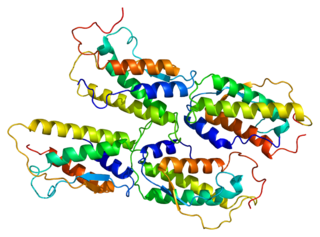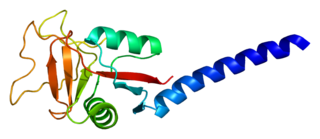
Haematopoiesis is the formation of blood cellular components. All cellular blood components are derived from haematopoietic stem cells. In a healthy adult person, approximately 1011–1012 new blood cells are produced daily in order to maintain steady state levels in the peripheral circulation.

Interleukin 3 (IL-3) is a protein that in humans is encoded by the IL3 gene localized on chromosome 5q31.1. Sometimes also called colony-stimulating factor, multi-CSF, mast cell growth factor, MULTI-CSF, MCGF; MGC79398, MGC79399: the protein contains 152 amino acids and its molecular weight is 17 kDa. IL-3 is produced as a monomer by activated T cells, monocytes/macrophages and stroma cells. The major function of IL-3 cytokine is to regulate the concentrations of various blood-cell types. It induces proliferation and differentiation in both early pluripotent stem cells and committed progenitors. It also has many more specific effects like the regeneration of platelets and potentially aids in early antibody isotype switching.

CD34 is a transmembrane phosphoglycoprotein protein encoded by the CD34 gene in humans, mice, rats and other species.

Proto-oncogene c-KIT is the gene encoding the receptor tyrosine kinase protein known as tyrosine-protein kinase KIT, CD117 or mast/stem cell growth factor receptor (SCFR). Multiple transcript variants encoding different isoforms have been found for this gene. KIT was first described by the German biochemist Axel Ullrich in 1987 as the cellular homolog of the feline sarcoma viral oncogene v-kit.

Stem cell factor is a cytokine that binds to the c-KIT receptor (CD117). SCF can exist both as a transmembrane protein and a soluble protein. This cytokine plays an important role in hematopoiesis, spermatogenesis, and melanogenesis.

C-type lectin domain family 4 member M is a protein that in humans is encoded by the CLEC4M gene. CLEC4M has also been designated as CD299.

Fms-related tyrosine kinase 3 ligand (FLT3LG) is a protein which in humans is encoded by the FLT3LG gene.

Homeobox protein Hox-B6 is a protein that in humans is encoded by the HOXB6 gene.

C-type lectin domain family 7 member A or Dectin-1 is a protein that in humans is encoded by the CLEC7A gene. CLEC7A is a member of the C-type lectin/C-type lectin-like domain (CTL/CTLD) superfamily. The encoded glycoprotein is a small type II membrane receptor with an extracellular C-type lectin-like domain fold and a cytoplasmic domain with a partial immunoreceptor tyrosine-based activation motif. It functions as a pattern-recognition receptor for a variety of β-1,3-linked and β-1,6-linked glucans from fungi and plants, and in this way plays a role in innate immune response. Expression is found on myeloid dendritic cells, monocytes, macrophages and B cells. Alternate transcriptional splice variants, encoding different isoforms, have been characterized. This gene is closely linked to other CTL/CTLD superfamily members on chromosome 12p13 in the natural killer gene complex region.

Tetranectin is a protein that in humans is encoded by the CLEC3B gene.

C-type lectin domain family 1 member B is a protein that in humans is encoded by the CLEC1B gene.

Chemokine-like factor is a protein that in humans is encoded by the CKLF gene.

C-type lectin domain family 2 member D is a protein that in humans is encoded by the CLEC2D gene.

C-type lectin domain family 4 member A is a protein that in humans is encoded by the CLEC4A gene.

C-type lectin domain family 1 member A is a protein that in humans is encoded by the CLEC1A gene.

Myeloid-associated differentiation marker is a protein that in humans is encoded by the MYADM gene.

C-type lectin domain family 2 member B is a protein that in humans is encoded by the CLEC2B gene.

C-type lectin domain family 12 member A is a protein that in humans is encoded by the CLEC12A gene.

C-type lectin domain family 10 member A also known as CLEC10A is a protein that in humans is encoded by the CLEC10A gene.

C-type lectin domain family 5 member A (CLEC5A), also known as C-type lectin superfamily member 5 (CLECSF5) and myeloid DAP12-associating lectin 1 (MDL-1) is a C-type lectin that in humans is encoded by the CLEC5A gene.



















